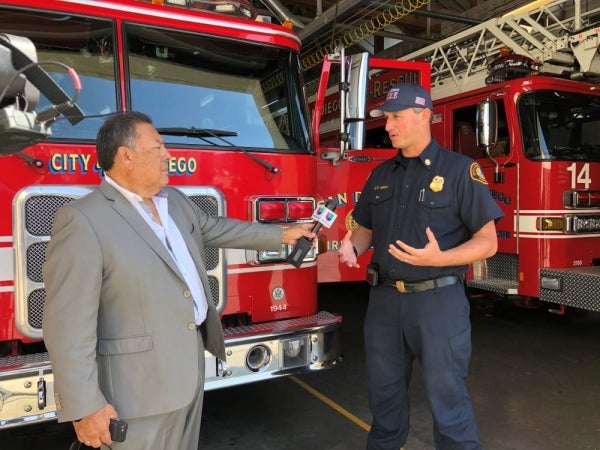Inclusive Engagement Techniques and Approaches
TV/Radio/Podcast Interviews

What is it?
The City is often featured in media interviews. In a media interview, a City employee with significant knowledge about a given subject will go on radio, television (TV) or internet streaming to answer questions asked by a news reporter, podcast host or other on-air personality and share information about a City project. Note that interviews can be pre-recorded or live. Pre-recorded interviews tend to be longer segments, which are later edited, while live interviews are typically shorter.
When to use it
TV or radio interviews, along with podcasts and social media platform content, can help inform community members about City projects that may already have an element of public interest and/or invite the broader public to participate in upcoming public engagement events. TV interviews and social media videos can help the City connect with viewers and listeners by focusing on the people behind the project or program, and by visually displaying the significance of projects that may be harder to explain through text or voice alone. If a news or media station or show host requests an interview, or there is an interest in featuring a City project in a media interview, it is critical to first consult the department’s Public Information Officer or the Communications Department.
How to do it
Before
- The City has an established process for participating in TV, radio or podcast interviews for departments with an assigned Public Information Officer. Departments should coordinate with their Public Information Officer.
- The department’s Public Information Officer can help to identify logistics, including the time, location and format.
- The department’s Public Information Officer can assist the coordination between the department and the media outlet.
- The department’s Public Information Officer can assist with facilitating the interview and address any follow-up.
- In preparation for an interview, staff should:
- Prepare key messages, including what the project is about, its importance to the public and whether the public should take any action(s).
- Set time aside for interview practice.
During
- Tips for in-person interviews include:
- Maintain eye contact with the reporter, not the camera.
- Avoid jargon and acronyms and speak in plain and clear language.
- Stand or sit still with a smile when appropriate.
- Dress professionally in solid colors.
- Best practices for virtual interviews:
- Test the computer and audio in advance.
- Adjust the camera to be centered and at eye level.
- Clear the background of anything distracting. Consider using a City-issued virtual background (accessible to City staff only).
- Adjust lighting and consider facing a window for optimal conditions.
After
- The department’s Public Information Officer or Communications Department can help address any follow-up.
- In coordination with the department’s Public Information Officer or Communications Department, consider sharing snippets of interviews on social media to reach a larger audience, with links to the original story for the public to easily find more information.
Resource considerations
![]()
Cost: Minimal
There is no cost to this technique, which is why it is considered “earned media.” For paid media, please reference the Paid Advertising section.
![]()
Time: Minimal
Preparing for interviews can take anywhere from one day to several weeks. The department's Public Information Officer or Communications Department can help staff prepare for the interview as needed. The interview itself can take a few minutes up to several hours depending on the format.
![]()
Capacity: Moderate
Interviews may involve several members of a team, as well as the department’s Public Information Officer or Communications Department.
Other considerations
- Do not speak “off the record” – assume everything is being recorded and can be shared publicly.
- Take a breath before answering to create calm and have time to formulate an answer.
How to make it more inclusive
Some inclusionary efforts may need to be joint efforts with the news outlet conducting the interview and may be handled by the department’s Public Information Officer or Communications Department.
- Request a transcript, closed captioning and translation options for audible and visual accessibility.
- Consider participating in other language interviews with media outlets that provide news and information for different linguistic groups.
- Calls to action shared during the interview should be reasonable, achievable asks for any community member.
Inclusive Engagement Techniques and Approaches
- Introduction
- Appreciative Inquiry
- Arts-based Engagement
- Briefings
- Comment Forms
- Community Cafés
- Community Mapping
- Community Office Hours
- Email Notifications
- Engagement through Service
- Fact Sheets
- Flyers
- Focus Groups
- Game-based Approaches
- Hotlines
- Information Kiosks
- Interviews
- Meeting in a Box
- Mobile Engagement
- News Releases
- Newsletters
- Open Houses
- Participation Support
- Pop-Up Events
- Project Models
- Project-specific Groups
- Public Meetings
- Public Service Announcements (PSAs)
- Social Media
- Surveys and Polls
- Tours and Field Trips
- TV/Radio/Podcast Interviews
- Vision Walls
- Web-Based/Hybrid Meetings
- Webpages
- Workshops


 Inclusive Public Engagement Guide
Inclusive Public Engagement Guide